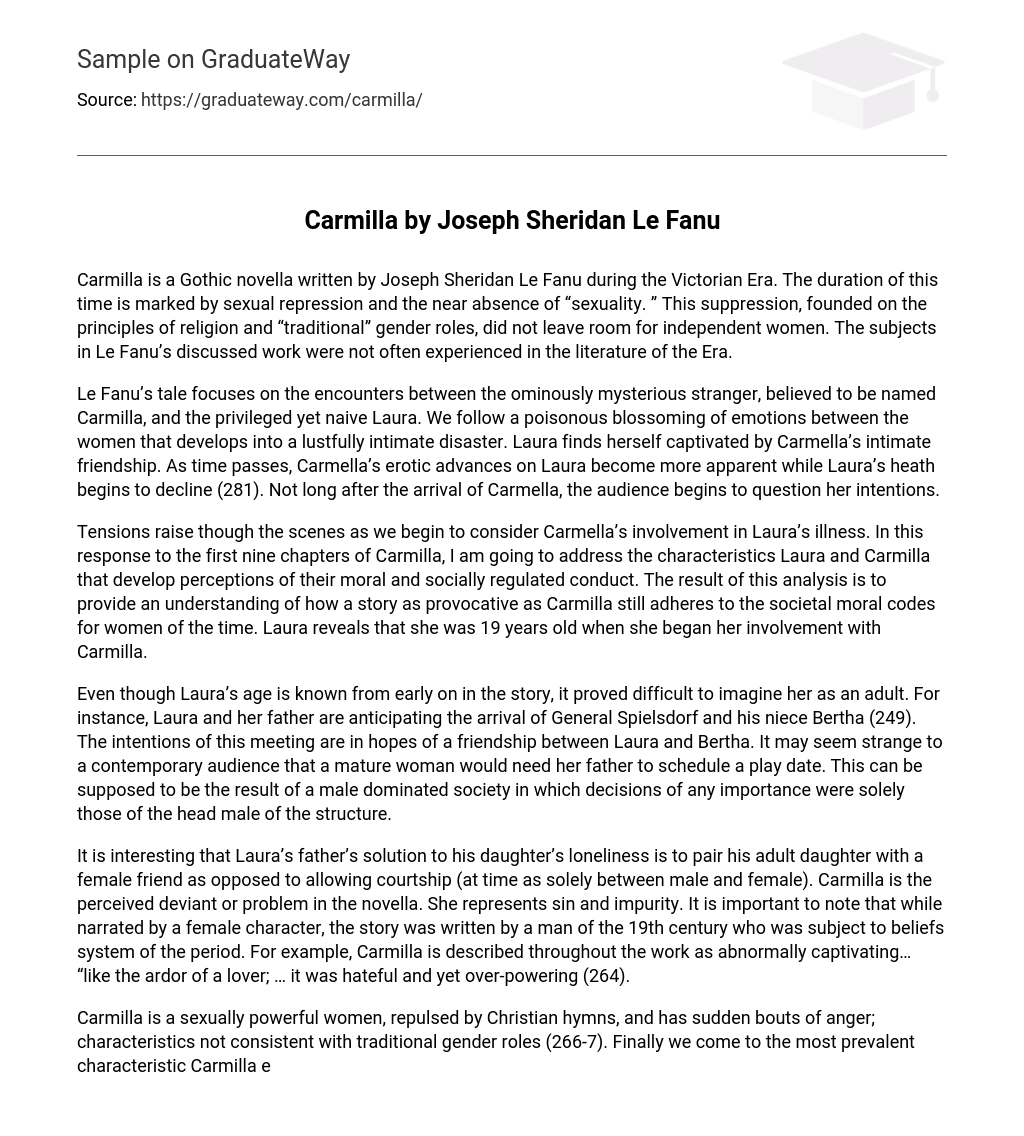Carmilla is a Gothic novella written by Joseph Sheridan Le Fanu during the Victorian Era. The duration of this time is marked by sexual repression and the near absence of “sexuality. ” This suppression, founded on the principles of religion and “traditional” gender roles, did not leave room for independent women. The subjects in Le Fanu’s discussed work were not often experienced in the literature of the Era.
Le Fanu’s tale focuses on the encounters between the ominously mysterious stranger, believed to be named Carmilla, and the privileged yet naive Laura. We follow a poisonous blossoming of emotions between the women that develops into a lustfully intimate disaster. Laura finds herself captivated by Carmella’s intimate friendship. As time passes, Carmella’s erotic advances on Laura become more apparent while Laura’s heath begins to decline (281). Not long after the arrival of Carmella, the audience begins to question her intentions.
Tensions raise though the scenes as we begin to consider Carmella’s involvement in Laura’s illness. In this response to the first nine chapters of Carmilla, I am going to address the characteristics Laura and Carmilla that develop perceptions of their moral and socially regulated conduct. The result of this analysis is to provide an understanding of how a story as provocative as Carmilla still adheres to the societal moral codes for women of the time. Laura reveals that she was 19 years old when she began her involvement with Carmilla.
Even though Laura’s age is known from early on in the story, it proved difficult to imagine her as an adult. For instance, Laura and her father are anticipating the arrival of General Spielsdorf and his niece Bertha (249). The intentions of this meeting are in hopes of a friendship between Laura and Bertha. It may seem strange to a contemporary audience that a mature woman would need her father to schedule a play date. This can be supposed to be the result of a male dominated society in which decisions of any importance were solely those of the head male of the structure.
It is interesting that Laura’s father’s solution to his daughter’s loneliness is to pair his adult daughter with a female friend as opposed to allowing courtship (at time as solely between male and female). Carmilla is the perceived deviant or problem in the novella. She represents sin and impurity. It is important to note that while narrated by a female character, the story was written by a man of the 19th century who was subject to beliefs system of the period. For example, Carmilla is described throughout the work as abnormally captivating… “like the ardor of a lover; … it was hateful and yet over-powering (264).
Carmilla is a sexually powerful women, repulsed by Christian hymns, and has sudden bouts of anger; characteristics not consistent with traditional gender roles (266-7). Finally we come to the most prevalent characteristic Carmilla exhibits throughout the story; desire for Laura. In chapter four, Laura found it strange that Carmilla became upset with the singing of Christian hymns and had never been seen praying. Christianity was very prominent in the 19th century and much like modern times served as the model of moral vs. immoral conduct.
The Christian bible does not permit same-sex relations or such lust. Carmilla is then perceived as having an absence of religion or God and therefore the deviant “other. ” Laura, who represents purity and innocence, falls prey to the evil, corrupt behaviors of Carmilla. To conclude, I want to clarify the distinctions between the characteristics of Laura and Carmilla. Laura plays the role of the “right/good” as she follows the socially accepted norms (for a woman) of the time: passive, performs traditional gender role, submissive, innocent, dominated by the male, and pure.
Carmilla plays the role of the “bad/evil” by seducing a woman, rejecting religion, keeping secrets, and being independent. The taboo of sexuality other than heteronormative is broken when Carmilla demonstrated her intimate affections for Laura and thus for the first time exposed women’s sexuality in the Victorian Era. These types of ideas could not be tolerated by Victorian standards and had to be punished to maintain the status quo.





